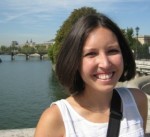Thanks so much to my fellow author, Kate Lansing, for including me in today’s Blog Hop. I’ve been lucky enough to meet a fantastic group of storytellers since becoming a full-time writer, and I’m excited to join their conversation about writing. And now, let’s hop to it!
What are you working on?
I’m doing final edits on a novel called Requiem in La Paz, a dark romantic fantasy set in contemporary Bolivia.
The novel was inspired by several trips to Bolivia, including concert tours with a string quartet and orchestral performances at a music festival. It’s definitely a novel about classical music, but it’s also a Persephone narrative–a story about a girl facing Death.
How does your work differ from others in the genre?
Requiem in La Paz is based on the idea of a Faustian bargain. The “deal with the devil” is certainly a story that we think we know. But Requiem also brings in pre-Inca mythologies and contemporary Bolivian folk traditions, and these elements drive the narrative in unexpected ways.
I love reading stories about the magical nature of music: Emma Bull’s rock & roll fantasy War for the Oaks, for example, is one of my all-time favorite novels. Requiem in La Paz places that theme of magic and music in a South American context.
Why do you write what you do?
Toni Morrison once said, “If there’s a book that you want to read, but it hasn’t been written yet, then you must write it.”
When I first visited Bolivia, I knew I wanted to return to La Paz. I knew there was a book that hadn’t been written yet. It was a story about a young indigenous musician and his struggle to support the arts in a country that was very poor. It was a story about another musician facing the consequences of her actions, seeking a second chance. I needed to write that story. So I came back to Bolivia, again and again, and I tried my best to learn everything I could about its history, music, and culture.
How does your writing process work?
When I write, I begin with a few characters and a controlling idea, and I allow the story to evolve. There are multiple drafts. Until I know how a story ends (which may take awhile), I don’t bother with an outline. The important thing is to remain open.
For example, in my earliest draft there was a mysterious doctor pursuing my protagonist. I asked my father for some advice to develop the doctor’s character, and he directed me to the work of his friend Arthur C. Aufderheide, one of the pioneers in the field of paleopathology. Pretty soon, I was reading Dr. Aufderheide’s magnum opus, The Scientific Study of Mummies, and next thing I knew, there were mummies in my novel! If you remain open, your writing can take you to all sorts of places you don’t expect.
Thanks again to Kate Lansing for including me in this blog hop!
Kate has been one of the lynchpins of my writing group for over a year, and she’s an amazing critique partner and a gifted and crafty storyteller. Here’s Kate’s bio:

I’m Kate Lansing, and I write Cozy Mysteries and Young Adult Novels. The common thread to my stories is a love for setting, to feel like you’re experiencing a whole new world whether it’s a deadly take on the modern day office or the fantastical at the bottom of the ocean. I grew up in the Rocky Mountains where I shared my backyard with black bears, mountain lions, and herds of elk (although usually not at the same time). After graduating from CU Boulder with an Applied Math degree, I worked as a statistician for five years before giving it up to pursue my dream. I currently live in Denver, Colorado with my husband and our chair-napping tabby cat named Maple.
Be sure to check out Kate’s posts at KateLansing.com!